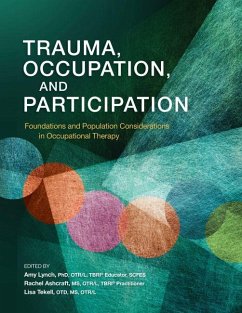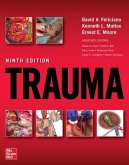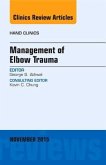Amy Lynch, Rachel Ashcraft, Lisa TekellFoundations and Population Considerations in Occupational Therapy
Trauma, Occupation, and Participation
Foundations and Population Considerations in Occupational Therapy
Herausgeber: Lynch, Amy; Ashcraft, Rachel; Tekell, Lisa
Amy Lynch, Rachel Ashcraft, Lisa TekellFoundations and Population Considerations in Occupational Therapy
Trauma, Occupation, and Participation
Foundations and Population Considerations in Occupational Therapy
Herausgeber: Lynch, Amy; Ashcraft, Rachel; Tekell, Lisa
- Broschiertes Buch
- Merkliste
- Auf die Merkliste
- Bewerten Bewerten
- Teilen
- Produkt teilen
- Produkterinnerung
- Produkterinnerung
Occupational therapy practitioners are valuable members of the complex trauma treatment team because of their expertise in the cognitive, social, emotional, and sensory components of occupation. This comprehensive text guides occupational therapy practitioners in applying trauma-responsive care with their clients.
Andere Kunden interessierten sich auch für
![Trauma, Ninth Edition Trauma, Ninth Edition]() David FelicianoTrauma, Ninth Edition309,99 €
David FelicianoTrauma, Ninth Edition309,99 €![Management of Elbow Trauma, an Issue of Hand Clinics Management of Elbow Trauma, an Issue of Hand Clinics]() George S. AthwalManagement of Elbow Trauma, an Issue of Hand Clinics97,99 €
George S. AthwalManagement of Elbow Trauma, an Issue of Hand Clinics97,99 €![Otolaryngologic Trauma, an Issue of Otolaryngologic Clinics of North America Otolaryngologic Trauma, an Issue of Otolaryngologic Clinics of North America]() Otolaryngologic Trauma, an Issue of Otolaryngologic Clinics of North America97,99 €
Otolaryngologic Trauma, an Issue of Otolaryngologic Clinics of North America97,99 €![Trauma, Stigma, and Autism Trauma, Stigma, and Autism]() Gordon GatesTrauma, Stigma, and Autism33,99 €
Gordon GatesTrauma, Stigma, and Autism33,99 €![Trauma, Bonding & Family Constellations Trauma, Bonding & Family Constellations]() Franz RuppertTrauma, Bonding & Family Constellations29,99 €
Franz RuppertTrauma, Bonding & Family Constellations29,99 €![The Routledge Handbook to Music under German Occupation, 1938-1945 The Routledge Handbook to Music under German Occupation, 1938-1945]() The Routledge Handbook to Music under German Occupation, 1938-194552,99 €
The Routledge Handbook to Music under German Occupation, 1938-194552,99 €![France Under the German Occupation, 1940-1944 France Under the German Occupation, 1940-1944]() Donna EvlethFrance Under the German Occupation, 1940-194466,99 €
Donna EvlethFrance Under the German Occupation, 1940-194466,99 €-
-
-
Occupational therapy practitioners are valuable members of the complex trauma treatment team because of their expertise in the cognitive, social, emotional, and sensory components of occupation. This comprehensive text guides occupational therapy practitioners in applying trauma-responsive care with their clients.
Produktdetails
- Produktdetails
- Verlag: American Occupational Therapy
- Seitenzahl: 400
- Erscheinungstermin: 30. Januar 2022
- Englisch
- Abmessung: 218mm x 279mm x 28mm
- Gewicht: 1186g
- ISBN-13: 9781569005996
- ISBN-10: 1569005990
- Artikelnr.: 63567524
- Herstellerkennzeichnung
- Libri GmbH
- Europaallee 1
- 36244 Bad Hersfeld
- gpsr@libri.de
- Verlag: American Occupational Therapy
- Seitenzahl: 400
- Erscheinungstermin: 30. Januar 2022
- Englisch
- Abmessung: 218mm x 279mm x 28mm
- Gewicht: 1186g
- ISBN-13: 9781569005996
- ISBN-10: 1569005990
- Artikelnr.: 63567524
- Herstellerkennzeichnung
- Libri GmbH
- Europaallee 1
- 36244 Bad Hersfeld
- gpsr@libri.de
* Part I. Foundations
* Chapter 1. Introduction to Trauma and the Role of Occupational
Therapy
* Chapter 2.Trauma Effects on Neurobiological, Social, Emotional, and
Motor Function: Considerations for Occupation
* Chapter 3. Trauma Across the Lifespan and Family Systems Theory:
Considerations for Occupational Therapy
* Chapter 4. Vital Collaborations with Other Providers: Unique and
Healing Roles
* Chapter 5. Occupational Therapy's Role in Trauma-Informed Population
Health
* Chapter 6. Becoming a Trauma-Informed Practitioner
* Part II. Contexts
* Chapter 7. Occupational Therapy in the Pandemic: Facing Challenges,
Building Resilience, and Sparking Innovation
* Chapter 8. Intimate Partner Violence and Occupational Therapy
* Chapter 9. Trauma-Informed Occupational Considerations Within
Contexts of Adoption, Foster Care, and Group Homes
* Chapter 10. Trauma-Informed Care in the Criminal Justice System
* Chapter 11. Human Trafficking and Occupational Therapy
* Chapter 12. Addressing LGBTQIA+ Trauma: Your Role and Your
Responsibility
* Chapter 13. Trauma-Informed Care: Historical and Modern Implication
of Racism and the Engagement in Meaningful Activities
* Chapter 14. Implications of Trauma on Occupational Engagement and
Performance for Individuals Living With Mental Health and
Substance-Related Challenges
* Chapter 15. Trauma-Informed Occupational Therapy for Displaced
Populations
* Chapter 16. Posttraumatic Growth and Occupational Therapy in
Traditional Adult Rehabilitation Settings
* Chapter 17. Trauma-Informed Care and Homelessness
* Chapter 18. Trauma and Occupational Therapy's Role in Schools and
Education
* Chapter 19. Trauma in Neurodivergent Populations
* Appendixes
* Appendix A. Resources for the Trauma-Informed Occupational Therapy
Practitioner
* Appendix B. AOTA Raises Critical Concerns About Effects of Separating
Children From Families
* Appendix C. AOTA Statement on Justice and Systemic Racism
* Chapter 1. Introduction to Trauma and the Role of Occupational
Therapy
* Chapter 2.Trauma Effects on Neurobiological, Social, Emotional, and
Motor Function: Considerations for Occupation
* Chapter 3. Trauma Across the Lifespan and Family Systems Theory:
Considerations for Occupational Therapy
* Chapter 4. Vital Collaborations with Other Providers: Unique and
Healing Roles
* Chapter 5. Occupational Therapy's Role in Trauma-Informed Population
Health
* Chapter 6. Becoming a Trauma-Informed Practitioner
* Part II. Contexts
* Chapter 7. Occupational Therapy in the Pandemic: Facing Challenges,
Building Resilience, and Sparking Innovation
* Chapter 8. Intimate Partner Violence and Occupational Therapy
* Chapter 9. Trauma-Informed Occupational Considerations Within
Contexts of Adoption, Foster Care, and Group Homes
* Chapter 10. Trauma-Informed Care in the Criminal Justice System
* Chapter 11. Human Trafficking and Occupational Therapy
* Chapter 12. Addressing LGBTQIA+ Trauma: Your Role and Your
Responsibility
* Chapter 13. Trauma-Informed Care: Historical and Modern Implication
of Racism and the Engagement in Meaningful Activities
* Chapter 14. Implications of Trauma on Occupational Engagement and
Performance for Individuals Living With Mental Health and
Substance-Related Challenges
* Chapter 15. Trauma-Informed Occupational Therapy for Displaced
Populations
* Chapter 16. Posttraumatic Growth and Occupational Therapy in
Traditional Adult Rehabilitation Settings
* Chapter 17. Trauma-Informed Care and Homelessness
* Chapter 18. Trauma and Occupational Therapy's Role in Schools and
Education
* Chapter 19. Trauma in Neurodivergent Populations
* Appendixes
* Appendix A. Resources for the Trauma-Informed Occupational Therapy
Practitioner
* Appendix B. AOTA Raises Critical Concerns About Effects of Separating
Children From Families
* Appendix C. AOTA Statement on Justice and Systemic Racism
* Part I. Foundations
* Chapter 1. Introduction to Trauma and the Role of Occupational
Therapy
* Chapter 2.Trauma Effects on Neurobiological, Social, Emotional, and
Motor Function: Considerations for Occupation
* Chapter 3. Trauma Across the Lifespan and Family Systems Theory:
Considerations for Occupational Therapy
* Chapter 4. Vital Collaborations with Other Providers: Unique and
Healing Roles
* Chapter 5. Occupational Therapy's Role in Trauma-Informed Population
Health
* Chapter 6. Becoming a Trauma-Informed Practitioner
* Part II. Contexts
* Chapter 7. Occupational Therapy in the Pandemic: Facing Challenges,
Building Resilience, and Sparking Innovation
* Chapter 8. Intimate Partner Violence and Occupational Therapy
* Chapter 9. Trauma-Informed Occupational Considerations Within
Contexts of Adoption, Foster Care, and Group Homes
* Chapter 10. Trauma-Informed Care in the Criminal Justice System
* Chapter 11. Human Trafficking and Occupational Therapy
* Chapter 12. Addressing LGBTQIA+ Trauma: Your Role and Your
Responsibility
* Chapter 13. Trauma-Informed Care: Historical and Modern Implication
of Racism and the Engagement in Meaningful Activities
* Chapter 14. Implications of Trauma on Occupational Engagement and
Performance for Individuals Living With Mental Health and
Substance-Related Challenges
* Chapter 15. Trauma-Informed Occupational Therapy for Displaced
Populations
* Chapter 16. Posttraumatic Growth and Occupational Therapy in
Traditional Adult Rehabilitation Settings
* Chapter 17. Trauma-Informed Care and Homelessness
* Chapter 18. Trauma and Occupational Therapy's Role in Schools and
Education
* Chapter 19. Trauma in Neurodivergent Populations
* Appendixes
* Appendix A. Resources for the Trauma-Informed Occupational Therapy
Practitioner
* Appendix B. AOTA Raises Critical Concerns About Effects of Separating
Children From Families
* Appendix C. AOTA Statement on Justice and Systemic Racism
* Chapter 1. Introduction to Trauma and the Role of Occupational
Therapy
* Chapter 2.Trauma Effects on Neurobiological, Social, Emotional, and
Motor Function: Considerations for Occupation
* Chapter 3. Trauma Across the Lifespan and Family Systems Theory:
Considerations for Occupational Therapy
* Chapter 4. Vital Collaborations with Other Providers: Unique and
Healing Roles
* Chapter 5. Occupational Therapy's Role in Trauma-Informed Population
Health
* Chapter 6. Becoming a Trauma-Informed Practitioner
* Part II. Contexts
* Chapter 7. Occupational Therapy in the Pandemic: Facing Challenges,
Building Resilience, and Sparking Innovation
* Chapter 8. Intimate Partner Violence and Occupational Therapy
* Chapter 9. Trauma-Informed Occupational Considerations Within
Contexts of Adoption, Foster Care, and Group Homes
* Chapter 10. Trauma-Informed Care in the Criminal Justice System
* Chapter 11. Human Trafficking and Occupational Therapy
* Chapter 12. Addressing LGBTQIA+ Trauma: Your Role and Your
Responsibility
* Chapter 13. Trauma-Informed Care: Historical and Modern Implication
of Racism and the Engagement in Meaningful Activities
* Chapter 14. Implications of Trauma on Occupational Engagement and
Performance for Individuals Living With Mental Health and
Substance-Related Challenges
* Chapter 15. Trauma-Informed Occupational Therapy for Displaced
Populations
* Chapter 16. Posttraumatic Growth and Occupational Therapy in
Traditional Adult Rehabilitation Settings
* Chapter 17. Trauma-Informed Care and Homelessness
* Chapter 18. Trauma and Occupational Therapy's Role in Schools and
Education
* Chapter 19. Trauma in Neurodivergent Populations
* Appendixes
* Appendix A. Resources for the Trauma-Informed Occupational Therapy
Practitioner
* Appendix B. AOTA Raises Critical Concerns About Effects of Separating
Children From Families
* Appendix C. AOTA Statement on Justice and Systemic Racism








